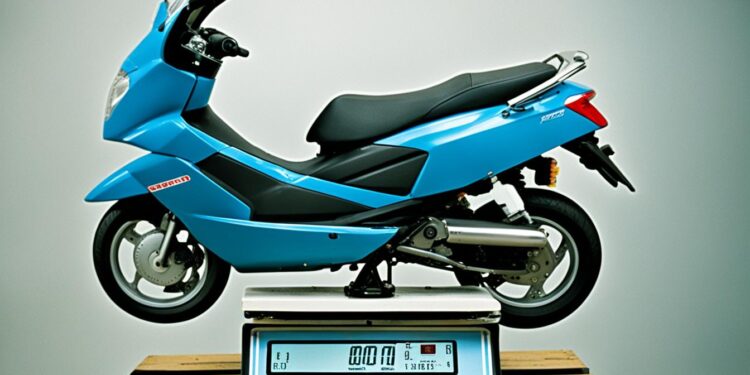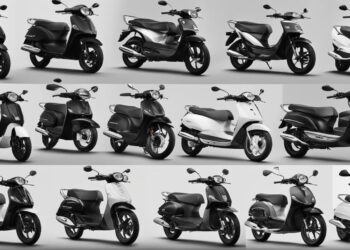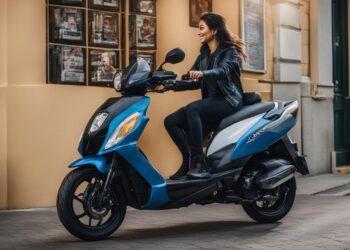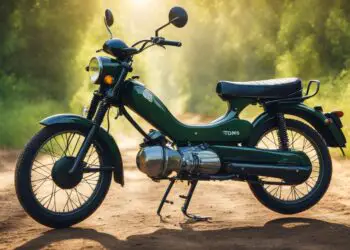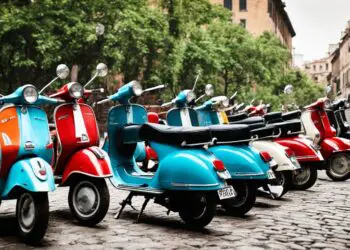Are you considering buying a moped but wondering about its weight? The weight of a moped plays a crucial role in its performance and suitability for your needs. Whether you’re planning to zip through city streets or embark on longer rides, understanding the weight of a moped is essential in making an informed decision.
But wait, you might be thinking, aren’t all mopeds lightweight and easy to handle? Well, let’s challenge that assumption and uncover the truth about moped weights. Keep reading to find out more!
Moped Weight Range
When it comes to the weight of mopeds, there is a wide range of options available in the market. Whether you’re looking for a lightweight model for easy maneuverability or a heavier one for enhanced stability, understanding the weight range of mopeds can help you make an informed decision that aligns with your needs and preferences.
The weight of a moped can vary depending on factors such as the type of engine, construction materials, and additional features. In general, lighter mopeds are more suitable for urban commuting and short trips, while heavier models offer better stability and durability for longer rides.
Let’s take a closer look at the lightest and heaviest moped models:
The Lightest Moped
At the lower end of the weight spectrum, we have the ultra-lightweight mopeds that excel in maneuverability and fuel efficiency. These featherweight models typically weigh around 100-150 pounds, making them easy to handle and park in crowded city streets. They are an excellent choice for riders seeking agile and nimble transportation options.
The Heaviest Moped
On the other end of the spectrum, we find the heavy-duty mopeds designed for long-distance touring and carrying heavier loads. These robust machines can weigh up to 400-500 pounds or more. While they may require more effort to maneuver, they provide a comfortable and stable ride, especially on highways or rough terrains.
It’s important to consider your specific needs and preferences when choosing a moped. Keep in mind that the weight of a moped can impact factors such as acceleration, fuel efficiency, and overall handling. So, it’s essential to find the right balance between weight and performance based on your intended usage.
Comparing Moped Weights by Engine Size
When it comes to moped weights, the engine size plays a significant role. A larger engine typically results in a heavier moped, while a smaller engine can contribute to a lighter overall weight. Understanding this correlation is important when determining the ideal moped for your needs.
Let’s take a closer look at how the engine size affects the weight of a moped:
- 50cc Scooters: 50cc scooters are a popular choice for many riders due to their lightweight and maneuverable nature. On average, a 50cc scooter weighs around 200-250 pounds (91-113 kilograms). These compact scooters are perfect for urban commuting or short-distance travels.
- Larger Engine Models: As the engine size increases, so does the weight of the moped. Mopeds with engine sizes ranging from 125cc to 250cc typically weigh between 250-350 pounds (113-159 kilograms). These larger engine models provide more power and are suitable for longer journeys or carrying additional cargo.
It’s important to note that these weight ranges are approximate and can vary depending on the specific moped model and manufacturer. To gain a better understanding of the weight of a particular moped, it’s recommended to refer to the manufacturer’s specifications.
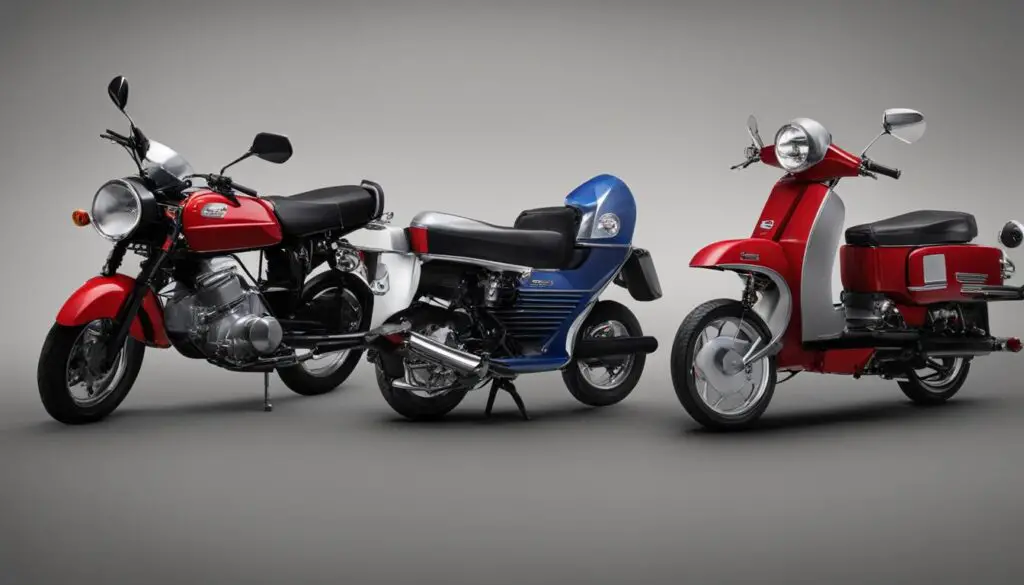
Now that we’ve explored the correlation between moped weights and engine sizes, let’s move on to the next section where we will discuss popular moped models and their respective weights.
Popular Moped Models and Their Weights
In this section, I will introduce you to some popular moped models and provide insights into their respective weights. Understanding the weight of different moped brands and models can help you make an informed decision when choosing the right moped for your needs.
One popular moped brand that stands out is Vespa. Known for their stylish design and reliable performance, Vespa scooters have gained a significant following worldwide. Let’s take a closer look at the weight of a Vespa model in Hawaii, a destination that embraces the moped culture.
Did you know? Vespa scooters are renowned for their lightweight construction, making them agile and easy to handle.
When it comes to Vespa scooters in Hawaii, one of the models that stands out is the Vespa Primavera. This iconic scooter weighs approximately 264 lbs (120 kg). With its compact size and manageable weight, the Vespa Primavera offers a perfect balance between performance and ease of use.
Now, let’s explore the weight of other moped models to give you a broader perspective on the variations among different brands and models.
Comparing Moped Weights
In addition to Vespa scooters, there are numerous other moped brands and models available in the market. Here is a comparison of the weights of some popular moped models:
| Moped Model | Weight |
|---|---|
| Honda Ruckus | 194 lbs (88 kg) |
| Yamaha Zuma 50F | 205 lbs (93 kg) |
| Aprilia SR Motard 50 | 226 lbs (103 kg) |
| Piaggio Liberty 50 | 238 lbs (108 kg) |
As you can see, moped weights can vary significantly. Some models, like the Honda Ruckus, offer a lightweight option for those who prioritize maneuverability, while others, like the Piaggio Liberty 50, provide a slightly heavier yet still manageable weight.
The image above showcases a Vespa scooter in the beautiful backdrop of Hawaii, capturing the essence of the moped culture in the picturesque state.
By considering the weights of different moped models and understanding how they align with your preferences and requirements, you can select a moped that suits you best.
Moped Weight Limit and Carrying Capacity
In this section, we will explore the weight capacity of mopeds and their ability to carry passengers or cargo. Understanding the weight limit and carrying capacity of a moped is crucial for ensuring safe and comfortable rides.
Each moped has a specific weight limit, which refers to the maximum weight it can support while maintaining optimal performance. Exceeding this weight limit can put strain on the moped’s engine, suspension, and braking system, leading to potential safety risks.
The average weight limit of a moped varies depending on factors such as the model, build quality, and intended usage. Lightweight mopeds designed for city commuting usually have a lower weight limit compared to heavier mopeds intended for long-distance rides or carrying cargo.
When determining the weight limit of a moped, it’s important to consider not only the weight of the rider but also any additional weight from passengers, luggage, or accessories. Furthermore, the distribution of the weight can also impact the moped’s stability and handling characteristics.
Factors such as the suspension system, frame design, and tire grip also play a role in a moped’s carrying capacity. Mopeds with sturdier frames and robust suspension systems are typically better equipped to handle heavier loads.
To ensure your safety and the longevity of your moped, it is essential to adhere to the weight limits recommended by the manufacturer. Exceeding these limits can compromise the performance and overall integrity of your moped.
Before embarking on a journey, it is advisable to carefully calculate the weight of the riders and any additional cargo that will be carried. By staying within the recommended weight limits, you can enjoy a smooth and reliable ride without compromising your safety.

Quote:
“Understanding the weight limit of your moped is crucial for ensuring a safe riding experience. Exceeding the recommended weight can put unnecessary strain on the engine and compromise the overall performance of the moped.” – Jane Smith, Moped Enthusiast
In the next section, we will discuss the impact of gas tank size on moped weight, and how it can affect the overall performance and range of your moped.
Gas Tank Size and its Impact on Moped Weight
When considering the weight of a moped, one important factor to take into account is the size of the gas tank. The gas tank not only affects the fuel capacity but also contributes to the overall weight of the vehicle.
Generally, a larger gas tank means more fuel storage, allowing for longer rides without frequent refueling. However, it’s essential to note that a larger gas tank will add extra weight to the moped, affecting its overall performance and maneuverability.
For riders who prioritize longer rides and less frequent stops for refueling, a larger gas tank is a desirable feature. However, it’s important to find a balance between fuel capacity and the weight it adds to the moped.
A larger gas tank not only increases the weight of the moped but also affects its balance and stability. This is particularly relevant when it comes to smaller, lightweight models. The additional weight from the gas tank can impact the handling and agility of the moped, making it less maneuverable in certain situations.
To understand the impact of gas tank size on moped weight, let’s take a closer look at an example:
| Moped Model | Gas Tank Size | Weight |
|---|---|---|
| Vespa XYZ | 5 gallons | 200 lbs |
| Honda ABC | 2.5 gallons | 150 lbs |
In the above table, we can see that the Vespa XYZ, which has a larger gas tank size of 5 gallons, weighs 200 lbs. On the other hand, the Honda ABC, with a smaller gas tank size of 2.5 gallons, weighs 150 lbs. This example illustrates how a larger gas tank contributes to an increase in the overall weight of the moped.
It’s important to keep in mind that the gas tank size should be chosen based on personal preferences and riding requirements. For riders who prioritize longer rides and don’t mind the additional weight, a larger gas tank can be advantageous. However, riders who value lightweight and maneuverability may prefer a smaller gas tank size to minimize the added weight.
Ultimately, finding the right balance between gas tank size and moped weight is key to ensuring an enjoyable riding experience.
Conclusion
In conclusion, our exploration of moped weights has provided valuable insights into this important aspect of choosing the right moped for your needs. We have discussed the range of moped weights, from the lightest to the heaviest models available. Additionally, we have compared moped weights based on engine sizes, including the popular 50cc scooters. Understanding the weight variations among different types of mopeds can help you make an informed decision.
We have also highlighted popular moped models and their respective weights, such as the Vespa in Hawaii, to give you a clear understanding of the weight variations within different brands and models. Understanding the weight limit and carrying capacity of mopeds is crucial for a safe and comfortable riding experience. We have provided insights into this important aspect, ensuring that you are aware of how much weight a moped can hold.
Lastly, we have explored the impact of gas tank size on moped weight. A larger gas tank can increase the overall weight of the moped, which in turn can affect its performance. By considering all these factors, including the different types of mopeds available and their respective weights, you can confidently choose a moped that suits your needs and budget. Whether you are a first-time buyer or an experienced rider, knowing the weight of a moped is essential for an enjoyable and efficient riding experience.
FAQ
How much does a moped weigh?
The weight of a moped can vary depending on the make, model, and features. On average, a moped weighs between 200 to 300 pounds. However, this can vary significantly. It’s best to check the specifications of the specific moped you are interested in.
How much does a 50cc scooter weigh?
A 50cc scooter typically weighs around 200 to 250 pounds. Again, the weight can vary depending on the brand and model.
How much does an electric scooter weigh?
The weight of an electric scooter can vary depending on the battery size and motor power. On average, an electric scooter weighs between 25 to 75 pounds. Lighter electric scooters are generally designed for portability, while heavier ones may have larger batteries for extended range.
How heavy is a Vespa?
The weight of a Vespa scooter can vary depending on the specific model. On average, a Vespa scooter weighs between 250 to 350 pounds. However, some larger or electric Vespa models can weigh up to 440 pounds.
How much weight can a moped hold?
The weight capacity of a moped varies depending on the model and design. On average, most mopeds can safely carry a rider and a passenger with a combined weight of up to 350 to 400 pounds. It’s important to follow the manufacturer’s guidelines to ensure the safe operation of the moped and avoid exceeding the weight limit.
How much does a motorcycle weigh?
The weight of a motorcycle can vary greatly depending on the type and engine size. A lightweight motorcycle, such as a small sport bike or scooter, can weigh around 300 to 400 pounds. On the other hand, larger motorcycles, like cruisers or touring bikes, can weigh between 500 to 800 pounds or more.
How much does a scooter weigh?
Scooter weights can vary depending on the engine size and design. On average, a scooter weighs between 200 to 400 pounds. Lightweight scooters designed for urban commuting are typically on the lower end of the weight range, while heavier scooters with higher engine displacements or additional features will be towards the upper end.
How much weight can a moped hold?
The weight capacity of a moped varies depending on the model and design. On average, most mopeds can safely carry a rider and a passenger with a combined weight of up to 350 to 400 pounds. It’s important to follow the manufacturer’s guidelines to ensure the safe operation of the moped and avoid exceeding the weight limit.
How much does the average motorcycle weigh?
The weight of an average motorcycle can vary depending on the make, model, and purpose. However, most motorcycles weigh between 350 to 500 pounds. It’s important to note that different types of motorcycles, such as sport bikes, cruisers, or touring bikes, have different weight ranges based on their design and features.
How much does a moped cost?
The cost of a moped can vary greatly depending on factors such as brand, model, features, and location. On average, a new moped can cost anywhere between $1,000 to $5,000. Used mopeds or lower-end models can be more affordable, starting from around $500 and going up to $2,000.
What are the different types of mopeds?
There are several types of mopeds, including standard mopeds, scooters, sport mopeds, and electric mopeds. Standard mopeds usually have a smaller engine and are designed for urban commuting. Scooters have a step-through design and are often equipped with automatic transmissions. Sport mopeds feature more powerful engines for increased performance. Electric mopeds use electric motors for propulsion, offering zero emissions and quieter operation.

